Boost Your Productivity: Embrace the Power of Additive Manufacturing
9 April 2024
We've put together some top tips in how to adopt Additive Manufacturing successfully, as featured in the Engineer. Read on for our thoughts!
Despite enduring a series of challenges, UK manufacturers have proven their resilience. Now, the spotlight is on enhancing productivity and supply chains to fuel growth.
Picture cutting your lead times in half or more. Improvement rates of 98.5%, 97% and 98% are the kind of efficiency boost engineers dream of, and with Additive Manufacturing it's a reality.3D printed nut bellows
3D printed nut bellows
Originally fabricated in sheet metal
Results from 3D printing:
- 98.5% lead time reduction from 5 weeks
- 96% cost saving

Part and photo courtesy of Mecmesin Limited (part of PPT Group UK)
As a direct result of using Additive Manufacturing, UK companies are achieving substantial savings in both time and cost. The bonus is that these results are just for a single application. Imagine the ripple effect it has on productivity gain, when it’s across 5, 10 or 15+ applications in your business.
From design development, research and prototyping to tooling and production aids; through to end-use parts, 3D printers are a staple of engineering and manufacturing firms, bringing a multitude of benefits, with productivity at the heart.
Ready to unlock the power of Additive Manufacturing?
Here are our top 3 tips as to how to successfully adopt AM.
Tip 1. Work to 80% not 100% of applications
We agree, 3D printed parts on space stations are very cool, but don’t start with your most challenging or niche applications. The most impactful use-cases are every-day applications that will see immediate benefits from incorporating Additive.
How do you identify those parts? We recommend thinking about…
- Which components have large MOQs, and which do we have to hold too much stock compared to our usage rate?
- What expensive tooling do we use?
- Where do we use “blue peter” tooling?
- Where do we need to reduce scrappage?
- What component parts have our longest lead times from suppliers?
Tip 2. Design for the process
Adjusting your design to the manufacturing process is key and built-in as part of subtractive manufacturing processes. Additive is no different. By designing correctly you will see better parts that are produced faster and at a lower cost.
DfAM (Designing for Additive Manufacturing) is about focusing on optimising the design for 3D printing. In most cases, it is fine-tuning, or making small adjustments. What’s more, designers and CAD engineers enjoy increased creativity in their thinking and design process, thanks to the greater geometric freedom offered by 3D printing.
How involved is DfAM? We describe it as a readjustment of thought away from how it’s been made before.
Some aspects to consider:
- Are square corners necessary? If so, use chamfers
- Can this part benefit from light-weighting? Hollowing a part does not always mean less structural integrity
- Can we improve this part functionality? For example, printing an assembly in one piece, rather than machining in multiple parts and assembling to remove a process
Tip 3. Just start now
There are plenty of routes to adopting AM, whether you outsource the service, or buy the equipment for use in-house, or use a mixture of the two.
The key is to start now.
The technology has been around since the 1980s, is well established, has great capabilities and is affordable. Your team will benefit from immediate time and cost savings, but you’ll also scale your learning faster and build your internal skills and knowledge.
The key to boosting productivity and achieving a fast return on investment, is matching your printer and material(s) to the application. There isn’t a one size fits all. The 3D printer will be another versatile tool in your problem-solving arsenal, and this can be built upon over time, as applications and usage widens across the business.